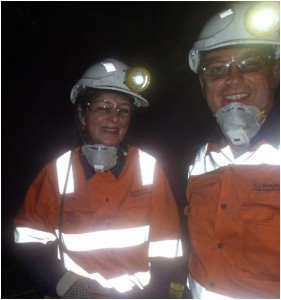10th April 2013
Down a coal mine
By a strange coincidence, I found myself down a coal mine on the day Margaret Thatcher died. The 1984-5 miners’ strike had been one of the many significant events of her premiership. There has been massive coverage of her death in the Australian media and comments from across the political spectrum paying tribute to Lady Thatcher’s profound role in shaping the UK’s economy and its place in the world. Opposition Leader Tony Abbott came into our Consulate General in Melbourne to sign the Condolence book, and members of the public are visiting our offices around Australia to do the same.

Australia is a coal “superpower”, the world’s fourth largest producer. 70% of its production is exported, mainly to Japan and other Asian markets. I was accompanying British peer Baroness Blackstone on a visit to West Cliff mine in the Illawarra region just south of Sydney. Our host was the Anglo-Australian resources giant BHP Billiton. Dual-listed, it is the largest company on the Australian Stock Exchange by market cap and one of the largest on the London exchange. It employs nearly 50,000 people worldwide and turned over more than US$70bn last year. It has operations all around Australia across a range of commodities.
It is a challenging industry to operate in, requiring massive, high tech investment to extract resources in often difficult or remote locations, over long time periods, and subject to volatile commodity prices and demanding environmental and climate change regulations.
Dark, dusty and sweaty, 500 metres below ground, watching the huge long wall “shearer” machine carve through a flaking coal seam like a butcher slicing ham, I felt that the relationship between humans and the earth was brought into sharp relief.